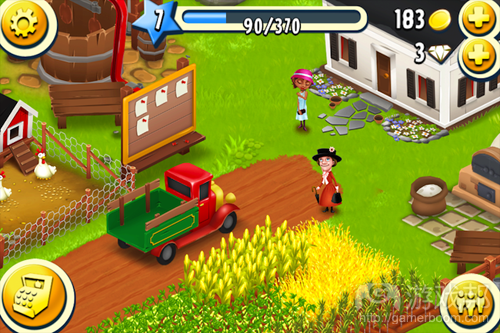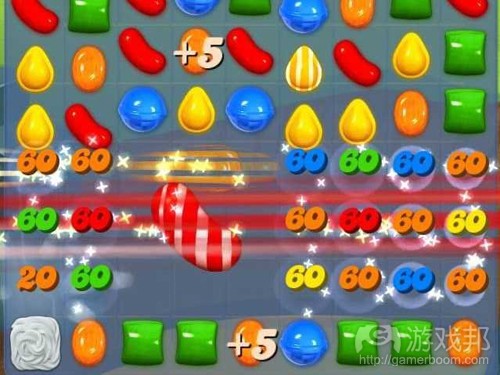情感赢利法——通过玩家情感拉动赢利
作者:David Hom
当我跟游戏开发者讨论产品的生产阶段时,我最经常听到问题是“有什么好办法能赚到更多钱?”最显而易见的回答(对他们而言)是“分析学”—-收集和分析玩家的行为数据,以理解消费者到底怎么玩游戏和如何最大化收益可能。然而,作为一个职业的游戏设计师,我总是更专注于游戏玩法而不是赢利策略。毕竟,如果游戏没有乐趣,游戏就完蛋了。这就是为什么我想在此介绍一个概念——我所谓遥“情感赢利法”。
分析学不可能量化或评估情感,而你的游戏最终是靠情感赢利的。有些开发者认为赢利策略就是A/B测试、市场细分和回报率。不是的。你必须通过优秀的玩法和设计使玩家与你的游戏建立情感上的联系。根据定义,游戏是一系列选择,旨在创造情感依恋和乐趣。当开发者构造的游戏机制允许玩家通过技巧、力量或运气做出自己的决定时,艺术和科学才融合成游戏。例如:
国际象棋中的一系列技巧决定:移动士兵或骑士带走车?
运动游戏中的一系列力量决定:传球还是射门?
老虎机游戏中的一系列运气决定:最大投注还是最小投注?
玩游戏是通过扮演虚拟角色如寻宝猎人、精英运动员或侦探等,暂时逃避现实生活。通过角色扮演,玩家可以感受到各种情感,如克服挑战的成就感、击败对手的快感、获胜的喜悦和同伴情谊等。
做决定然后获得奖励,如下循环反复。以类似的角度思考赢利策略。什么时候引入决定,或者说赢利点?另外,你希望在合适的时间创造情感依恋和展现决定。赢利点在玩法中出现得太早,会让玩家反感;出现得太晚,会错失许多增加收益的机会。以《Candy Crush》为例:第15关以后,玩家被迫在支持0.99美元和邀请3个好友来帮忙之间做出选择。如果是在第7关而不是第15关就要求玩家做决定,玩家的情感依恋还会一样吗?
现在问题是,你可以使用什么技巧或赢利策略?不同的游戏类型需要不同的技巧,但绝对不存在硬性规定。结合和混用不同的技巧可以使你的游戏显得与众不同和吸引人。独立开发者最擅长这个了。
以下是你可以尝试的不同类型的赢利策略:
计时机制
这就是在游戏的各种组件里放置计时器,包括支付跳过计时或等待时间走完。这个方法被广泛运用于手机游戏中需要升级或重置的东西。比如《实况赛车3》就在赛车中放置了计时器,使赛车升级后才能投入比赛。
计时机制为付费玩家和非付费但有耐心的玩家创造了一个公平的游戏环境。然而,你必须为选择等待的玩家提供其他东西玩,否则他们就不太可能长期留在你的游戏中。《实况赛车3》在这方面做得非常好,也就是当某辆车处于计时状态时,玩家仍然可以选择用其他赛车参加比赛。
值得注意的是,许多玩家都知道如何修改游戏中的计时器和设备的时间设置,以绕过这个机制。如果你想了限制这种作弊,就必须把计时器从客户端中移除,然后放在你自己的服务器里。
概率机制
概率机制在游戏中表现为多种形式:施放致命一击、掉落物品、发现宝箱或牌组等。玩家不能从决定中得到已知的结果,是否得到奖励取决于机率。这个机制还非常适用于稀有道具,使这种道具显得特殊、不花钱就难以获得。
未知是一种强大的策略。使玩家产生一种渴望得到某种稀有物品的情绪,通常可以长久地把玩家留在游戏中。你可以用这个机制代替数值变量(比如,把胜利条件从收集20个金币改成一个随机范围如15-25个金币)。
《Hay Day》就是一个好例子。收集宝物是很好玩,但当玩家没有存放宝物的空间时,游戏就不好玩了。每次拾取物品都有可能升级仓库或背包。甚至更好,在路边商店有可能找到仓库。耐心的玩家可以慢慢收集,但购买IAP赶进度的吸引力非常强。
刷机制
这是普遍运用于免费游戏的机制,给玩家选择免费玩或付费玩(加快进度)的机会。一旦游戏中建立起虚拟经济和商店,这类机制通常最容易执行。IAP道具如金币倍增器,可以减少刷游戏的时间,对于想快乐玩游戏的玩家来说是必须的。《Subway Surfers》把虚拟经济与IAP商店相给合,效果很好。玩家可以长时间免费玩,也可以购买金币来跳过某些玩法。
“刷”玩法比较多的游戏能否保持乐趣和赢利之间的平衡,很大程度上取决于虚拟经济。如果玩家不能及时得到积极的反馈,玩家要能会很快失去兴趣。应该想办法避免没有情感奖励的重复玩法和寻找调整游戏变量的方法,因为当玩家被要求刷游戏时,他们就会寻找和利用循环的漏洞。
付费继续机制
这个机制类似于“共享软件”或“精简版”,也就是除非付费,否则某些功能或特性不可用。带有付费继续机制的游戏似乎没有开发者期望中的那么成功。
幸运的是,因为免费游戏也能为非付费玩家提供丰富的体验,所以这类游戏最近越来越少见了。在大多数时候,当被迫决定付费或停止游戏时,玩家通常选择玩另一款游戏。如果你的游戏中有付费继续机制,那你就要保证玩家可以继续玩之前的关卡或者付费玩后面的关卡。
《Candy Crush》是一个好例子。玩家通完15个关卡后,必须选择付费或邀请朋友,才能解锁后面的关卡。虽然邀请朋友似乎比付钱更简单,但这个选项有利于留住玩家。
赌博机制
这种机制不言自明,就是类似于老虎机或扑克游戏。这是将传统的游戏与其他机制相混合形成的一条灰色带。根据分类,开发者很容易把传统的赌博方法和虚拟的扑克游戏和老虎机游戏相给合,比如《Zynga Poker》、《Big Fish Casino》和《Slotomania》。
总之,免费游戏的赢利策略不是现成的,而是将艺术与科学融合,或者叫作“情感赢利法”。你必须站在玩家的立场上,真正理解他们的感受。更重要的是,让玩家对你的游戏产生情感。不同的游戏会使不同的人产生不同的情感,情感是一种伟大的(赢利)力量。(本文为游戏邦/gamerboom.com编译,拒绝任何不保留版权的转载,如需转载请联系:游戏邦)
Emotional Monetization – Driving Rev Through Emotion
by David Hom
When I talk to game developers about their games in various stages of production, the most common question I get is “what is the best strategy to make more money?” The most obvious answer (to them) is “analytics”– gathering behavioral data and analyzing player behavior to understand actual consumer game play and maximizing revenue potential. However, as a game designer by trade, I usually always focus on the gameplay rather than the monetization tactics. After all, if the game isn’t fun, game over. This is why I’d like to introduce a concept I call Emotional Monetization.
Analytics simply can’t quantify or measure emotion, and emotion is what will ultimately help your game monetize. Some developers think that monetizing is all about A/B testing, segmentation and return rates. It’s not. You need to establish an emotional connection with your players through engaging gameplay and amazing design. By definition, games are series of decisions, designed to create emotional attachment and be fun. Art and science become a game when a developer constructs game mechanics that allows gamers to make their own decisions with skill, strength or luck. For example:
Skill decisions are a series of chess moves: move the pawn or knight to take the rook?
Strength decisions are a series of physical and mental moves in sports: pass or shoot the ball?
Luck decisions are a series entries when playing slot machines: max bet or one coin?
Games are played to temporarily escape from current life by role playing a life as a treasure hunter, elite athlete, or puzzle solver. Through role playing, gamers can experience emotions, such as: overcoming challenge, defeat, success, and camaraderie.
So, make a decision, reap the reward, and repeat. Think about monetization through a similar lens. When do you introduce the decision, or in this case the point of monetization? Again, you want to create an emotional attachment and present the decision at the right time. Too early in gameplay and it’ll be a turnoff to your players. If you incorporate it too late, you may be giving up on an opportunity to drive revenue. An example of precise timing can be found in Candy Crush where after 15 levels, the player is forced to decide to either pay $.99 or ask three friends for help. Would your players’ emotional attachment be different if it were 7 levels instead of 15?
Now that question is, what technique or monetization gate do you use? The game genre may lend itself to a particular technique, but there are definitely no hard and fast rules. Combining and mixing them can make your game different and compelling. Indie devs are great at this.
Here’s a rundown of the different types of monetization gates you can incorporate into your game:
Time Gates
This type of Gate places timers on various components within a game, which include pay to bypass the timer or wait for the timer to elapse. This is a commonly used tactic in mobile games that represent something being upgraded, built, recharged or repaired. An example is Real Racing 3 where there is a timer placed on the car after upgrading before it can be entered into a race.
Time Gates enables a level playing field for paying and non-paying gamers who are patient. However, you need to offer other things for the player to do while waiting for the component, otherwise they are unlikely to stay for the long term. Real Racing 3 does this well where one car is under a timer, but the other cars can still enter races.
One thing to watch out for is that many gamers know how to bypass this mechanic by changing the time and date settings on the device. If you want to limit cheating, put the timer in your server and remove it from the client.
Probability Gate
The probability gate can be presented to the gamer in various forms such as: landing a critical hit, reward loot, a treasure chest, or pack of cards. Instead of receiving a known return for a decision, the reward a gamer receives is left to chance. This game also emphasizes rare items, which can be used to make games feel special but are difficult to acquire without payment.
The ideology of the unknown is a powerful tactic. Creating an emotion where gamers are excited to have the opportunity to receive something rare keeps gamers coming back for more. You can use this concept in standard game mechanisms as well by replacing static variables (e.g. 20 coins for a victory) with a randomized range (15-25 coins).
Hay Day is a good example. It’s great to collect resources from a lot of farming, but not as great when the gamer runs out of room to store it. Every time a crop is picked up there is a chance to collect rare pieces to upgrade the barn or silo. Even better, there’s the opportunity to find the barn pieces in the Roadside Shop. The patient player can eventually get the pieces required, but the urge to speed up the process with an In App Purchase (IAP) is strong.
Grind Gates
A common gate used in all free to play (F2P), which allows for users to decide to play the game a lot (for free) or pay (to advance faster). This type of gate is usually the easiest to implement into a game once a virtual economy and store is established. IAP items such as coin doublers and coin triplers, are levers used to reduce the grinding necessary for gamers to enjoy a game. Subway Surfers does a good job with integrating a virtual economy and IAP store. Gamers can play a lot and enjoy the game or they can buy coin packs to bypass some gameplay.
Games that focus on grinding have a difficult balance of having fun versus monetizing and are heavily dependent on the virtual economy. If there’s a low or no positive player feedback early on, the gamer could lose interest quickly. Devise ways to avoid repetition without emotional rewards and look into methodologies that would allow game variables to be tuned remotely because when gamers are asked to grind, loop holes are found and used.
Look into methodologies that would allow game variables to be tuned remotely. When gamers are asked to grind, loop holes are found and used.
Premium Gates
This type of gate is analogous to the old term shareware or lite, where a player is not given access to features or levels unless they pay. Games with premium gates often reflect a previously paid title that hasn’t been as successful as hoped.
Fortunately, we’re seeing less and less of these types of games recently in favor of F2P games that offer rich experiences to non-paying users. In most cases, when forced to decide to pay or not to continue the decision made is often go find another game. If you add a premium gate, make sure gamers have the opportunity to play previous levels or give other options to enjoy and consider paying to move forward.
Candy Crush is a good example of a premium gate that hasn’t turned off players. After beating about 15 levels, there comes a point where gamers have to pay or ask their social network for help to unlock. While asking a social network for help may sound easy to do instead of paying for more, this action helps keep more players playing the game.
Gambling Gates
This type of gate is pretty self explanatory with slot and poker games. There is an obvious gray layer here with games that mix traditional games with other mechanics. For categorization methods, it’s easier to stick to traditional methods of gambling with virtual poker and slots. Examples: Zynga Poker, Big Fish Casino, and Slotomania
In conclusion, F2P monetization is not plug-and-play, rather a blend of art and science, or “Emotional Monetization.” You need to sit in your players seat, get in their head, and truly understand what they’re feeling. Practice sending the emotional shifts in your select games and more importantly ask other people the same questions about games. Every game will trigger different emotions for different people, and gauging emotion can make all the difference in the world.(source:gamasutra)









































 闽公网安备35020302001549号
闽公网安备35020302001549号